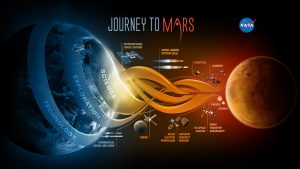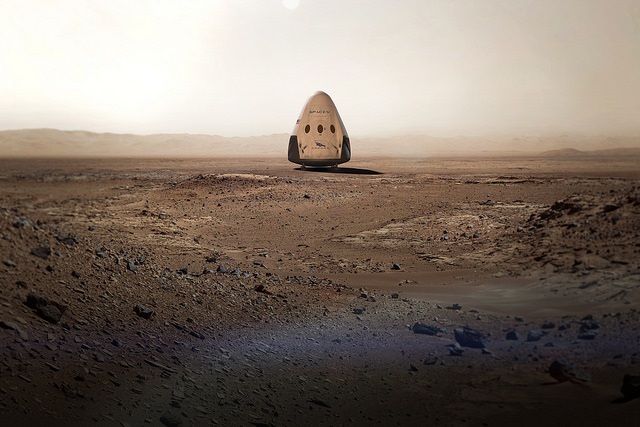SpaceX
How does SpaceX measure up to other Mars-destined challengers? [Countdown to Mars, Part 1]
SpaceX isn’t the only organization with eyes set on the skies of Mars. There are other dreamers with their own plans and technology. How does SpaceX measure up?
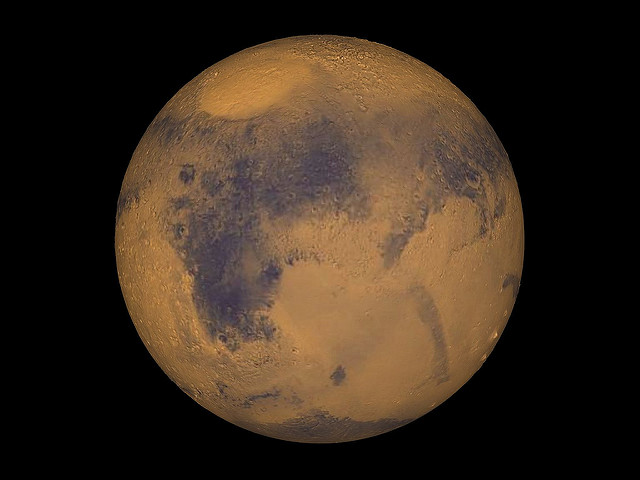
If it wasn’t entirely clear before, it is now with all the recent announcements from SpaceX: Elon Musk said “Mars”, and he really meant Mars. While Falcon 9 hits milestone after milestone, SpaceX inches closer and closer to “boots on the ground” in red, Martian regolith.
SpaceX isn’t the only organization with eyes set on Martian skies, however. There are other dreamers with their own plans and technology, NASA being a “given” of course. After all, if we’re going to Mars, it’s natural to expect the agency that sent humans to the moon to have something to say about sending humans to another planetary body.
Who all is planning on going to Mars?
To be clear, the Mars planners I’m referring to here are developing full missions for human transport, not just robotics. Further, I’m narrowing the criteria to only include those actively developing the technology rather than working on related scientific studies, developing artistic concepts, engineering helpful devices, and so forth.
In that light, it seems the field thus far consists of two other major players besides SpaceX.
NASA
Aptly named, NASA’s “Journey to Mars” program consists of developing all the capabilities needed to achieve what its designation implies. Their vision comprises the development of their next generation rocket, the Space Launch System, coupled with a crew capsule called Orion.
The Space Launch System has three primary components: One main core and two solid rocket boosters, most components being either derived or upgraded from space shuttle technology. The plan is to “evolve” the configurations through three “blocks”, the third of which will be capable of handling all of the payload needs for a mission to Mars.
The Orion capsule, nicknamed “Apollo on steroids”, is very similar to the capsules used in the Apollo programs, but with significant upgrades such as the heat shield that must handle higher reentry speeds. Further, it will house up to four astronauts (one more than Apollo) while supported by a service module, i.e., a connected structure that will provide resources such as power and oxygen. Overall, it’s about three feet wider than the Apollo capsules, an expansion which translates into a much roomier space square-footage wise.
Somewhere in NASA’s mix is an Asteroid Redirect Mission that involves capturing an asteroid, bringing it into orbit around the moon, and sending crews there to land and study it. Don’t see how that’s really related to Mars? Neither do I, but it’s included on all the “Journey to Mars” posters so it must be. I think I’ve heard people try and explain why the moon wouldn’t suffice for any Mars-related training as well, but I’m personally not convinced enough to really cite the argument. I’m not alone in that confusion, either.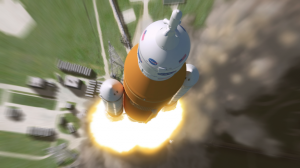
Personally, I’d prefer the pure scientific study of an asteroid to be the justification for the mission, or maybe even “practice” for a future Armageddon event, but when everyone is drumming for Mars, I guess you do what you can. I’ve read that NASA attempted to market it as both of those, but the attempts weren’t successful.
Oh, wait. They changed “asteroid” to “large boulder on an asteroid”. I wonder why? Some of their pages are still citing the original mission… Perhaps it was always either/or?
Speaking of that poster, there’s a space habitat and Mars transfer craft listed, but no other details are provided. NASA’s political and budgetary constraints seem to be limiting any details about how they plan on getting to Mars (landing in particular) once SLS and Orion are flying. These types of restrictions are the reason NASA even has other contenders for the mission, although those same challengers are the ones pushing the journey into the public drumming in the first place.
Mars One

Mars One is a non-profit foundation which hopes to send astronauts they select and train through an in-house application process to Mars via technology they will pay to have built and launched using current service providers.
Founded by Dutch scientist-entrepreneurs Bas Lansdorp and Arno Wielders in 2011, Mars One is an unusual player in the Mars transport game. It is not an aerospace company, as all systems are designed and built by outsourced companies, and their planned sources of funding are private investment and the creation of a reality show documenting the astronauts’ mission from training through their first steps on Mars (although they’ve had some recent troubles with that). Mars One would also like you to purchase plenty of merchandise in the meantime to support their efforts and have even set up a “point” system to encourage this.
For their astronauts, the company solicited applications from would-be space travelers around the world via the Internet, received about two hundred thousand responses, and is now in the process of narrowing down their candidate field to a maximum of twenty-four hopefuls (six groups of four, specifically) that will train together for the next ten years before groups are shuttled off to Mars every two years.
Mars One also plans on having their entire human habitat set up by rovers prior to the first astronaut arrivals, meaning there will be several cargo missions to the surface in the lead-up years. Their first unmanned mission is planned for 2020 wherein some tech will be put to the test along with placing a communications satellite in orbit. Then, a rover and second communications satellite is planned for 2022, followed by cargo missions in 2024 to have the habitat fully operational by 2025 in advance of the first crew arrival in 2027.
Oh, by the way, their trip to Mars will be one-way. According to them, it’s a strategic choice, not a matter of insurance liability for guaranteeing return.
While all space-going organizations face criticism in one way or another, the criticism lodged at Mars One is fairly significant, some even labeling the mission as a scam. To be fair, the nature of their mission combined with the lack of government backing or a billionaire founder puts them in the position that demands fundraising to be a primary activity. Add to that an estimated mission cost of six billion dollars and skepticism quickly rises. Everything involved becomes subject to close analysis.
Their plans aren’t impossible, of course, just full of challenges without perceivable solutions. I don’t personally believe the mission is a scam, and I don’t doubt its long-term viability should the astronauts actually make it to Mars; I think they won’t be the only crews visiting the planet come the days when their intentions match their funding needs, therefore a “back up” plan is essentially built-in. However, I also see a ten-year mission plan that is placing a lot of faith in contract work that is supposed to produce what SpaceX is still working on fourteen years after-the-fact and with a much better financial portfolio.
Honorable Mention: “Mars Direct” by The Mars Society
Founded in 1998 by Dr. Robert Zubrin (and “others”), The Mars Society has made humans on Mars their business for a very long time. Since they are not an organization primarily developing & building technology to go to Mars, I have to classify them as “honorable mention”; however, their contributions to the effort should definitely be noted. Elon Musk certainly has.
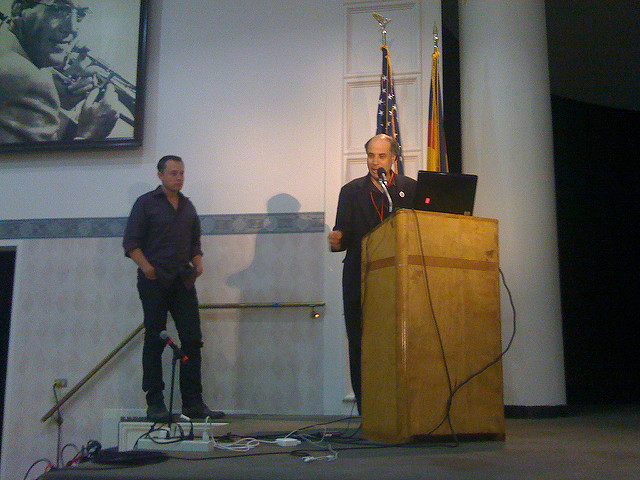
Dr. Zubrin of The Mars Society introduces Elon Musk. (Credit: Chris Radcliff under CC by SA-2.0.)
“Mars Direct” is The Mars Society’s detailed plan for putting humans on Mars and, like Mars One, it focuses on building components using existing technology to achieve orbit and landing rather than depending on future developments. It advocates a “live off the land” approach that minimizes cargo needs.
The Mars Direct mission would comprise two phases. First, using a heavy lift launch vehicle, a fuel generation structure would be sent to the Martian surface to generate a Methane/Oxygen bipropellant for a return trip and to power equipment. Second, another fuel generation structure plus a crew and habitat would be sent and landed near the first structure. While in orbit, the effects of zero gravity would be mitigated by rotation of the crew vehicle via a tether connected to the spent upper stage of the transport rocket to act as an anchor. The crew missions would necessarily require a two-year length due to the orbital proximities of Earth and Mars combined with the six-month travel time each way.
Unlike Mars One, this plan has been developed with incredible detail and was published in 1991 by Dr. Zubrin, David A. Baker, and Owen Gwynne. The Mars Society also has annual conferences (this year’s will be the 19th one) which both flesh out the plan’s details and feature speakers across the aerospace spectrum discussing the various aspects. Dr. Zubrin’s book, The Case for Mars, fleshes out the plan in a more readable format, and there’s also plenty of good stuff on the Mars One website.
SpaceX’s Plan for Mars
The founding goal of SpaceX was, and still is, making humans a multiplanet species. Therefore, no incredibly detailed introduction or lengthy explanation is really needed for them when discussing companies interested in going to Mars (see: publicity). However, for the sake of being thorough (and for the sake of sake’s sake), let’s review the Musk brand for Mars.
Known for its Falcon rocket series (along with its famous founder), SpaceX isn’t hitching a ride to Mars as is Mars One, thereby avoiding the potential pitfall of being “all dressed up with nowhere to go”. They’re building their own ride: The Falcon Heavy.
Scheduled for a test launch this November, the Falcon Heavy will be the most powerful rocket in operation since the Saturn V was used for the Apollo moon program. With three cores powered by nine Merlin engines each, Falcon Heavy will be able to haul around 120,000 pounds to low earth orbit (LEO), 50,000 pounds to geostationary transfer orbit (GTO), and 30,000 pounds of payload to Mars. Just for fun, SpaceX’s website also cites a 6,400 pound payload capacity for trips to Pluto.
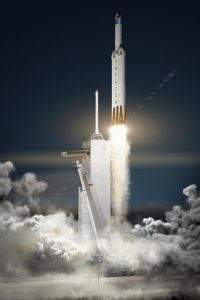 SpaceX is also developing their own crew capsule, the Dragon (“Red Dragon” when on its way to Mars), which will include a propulsive landing system (i.e., it can hover) via its eight SuperDraco engines. The landing system also doubles as an emergency escape system in the event that there’s a problem during launch, and while space traveling, Dragon will be supported by a “trunk” (essentially with the same function as Orion’s service module) to support missions as needed.
SpaceX is also developing their own crew capsule, the Dragon (“Red Dragon” when on its way to Mars), which will include a propulsive landing system (i.e., it can hover) via its eight SuperDraco engines. The landing system also doubles as an emergency escape system in the event that there’s a problem during launch, and while space traveling, Dragon will be supported by a “trunk” (essentially with the same function as Orion’s service module) to support missions as needed.
Now, pardon my excitement, but these things are really cool. The SuperDraco engines are doubled up and self-contained, meaning that the lander can lose up to half its engines and still land safely, and if anything goes wrong with one engine, it’s isolated to not impact the others. The engines are also 3D-printed out of Inconel, a high performance nickel-based super alloy.
Bonus level! SpaceX’s long-terms plans don’t just include short(ish) jaunts to Mars and back, although, unlike Mars One, there will be an option to return to Earth via regular cargo missions. There also may be an option with their up and coming Mars Colonial Transport vehicle.
The Mars Colonial Transporter is, at the moment, a mysterious development SpaceX is working on to achieve its goal of large-scale Martian colonization. There’s plenty of speculation about the details, but officially, even the size is being kept secret for now. Elon will only reveal it to be “So big.” A few details were shared (or speculations confirmed) during a Reddit “Ask Me Anything “ (AMA) session this past January such as:
- The second stage could be reusable
- The architecture will be completely different from the Falcon/Dragon system
- The goal payload capacity is 100 metric tons
- There is a family of methane-based engines called “Raptor” being developed by SpaceX for travel to and exploration of Mars.*
*Note: This detail wasn’t particularly new to the AMA, but there aren’t many original sources where Elon or a SpaceX executive has spoken directly about it, thus I’ve included it.
Overall, it certainly seems like SpaceX is charging ahead compared to the others that are aimed for Mars, but it’s not because of their publicity wins. Their steady march via the piece by piece development of the required technology combined with the customer-driven financial viability of the company as a rocket launch provider are key to the believably that they will actually make Mars “happen”.
Coming Up on Countdown to Mars…
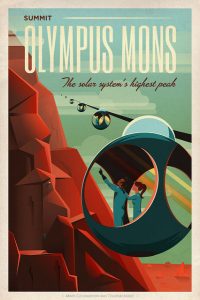 SpaceX’s colonial “grand plan” reveal is what I’m counting down to with this “Countdown to Mars” article series. Scheduled for September 26th – 30th of this year, Elon Musk has stated that he will be announcing detailed plans for their Mars Colonial Transporter at the International Astronautical Conference in Guadalajara, Mexico. It’s supposed to be so awesome, even Elon can hardly contain himself. To say that I’m incredibly excited as well would be a huge understatement. So I won’t. I’ll just keep writing about things related to it!
SpaceX’s colonial “grand plan” reveal is what I’m counting down to with this “Countdown to Mars” article series. Scheduled for September 26th – 30th of this year, Elon Musk has stated that he will be announcing detailed plans for their Mars Colonial Transporter at the International Astronautical Conference in Guadalajara, Mexico. It’s supposed to be so awesome, even Elon can hardly contain himself. To say that I’m incredibly excited as well would be a huge understatement. So I won’t. I’ll just keep writing about things related to it!
Coming up on “Countdown to Mars”…
How do these companies plan on solving some of the biggest challenges for achieving a successful mission to Mars? Then, if we are talking about permanent settlements on Mars, what will the human power structure look like? Or in other words, what kind of government will the first human Martians have?
Stay tuned!

Elon Musk
Starlink passes 9 million active customers just weeks after hitting 8 million
The milestone highlights the accelerating growth of Starlink, which has now been adding over 20,000 new users per day.

SpaceX’s Starlink satellite internet service has continued its rapid global expansion, surpassing 9 million active customers just weeks after crossing the 8 million mark.
The milestone highlights the accelerating growth of Starlink, which has now been adding over 20,000 new users per day.
9 million customers
In a post on X, SpaceX stated that Starlink now serves over 9 million active users across 155 countries, territories, and markets. The company reached 8 million customers in early November, meaning it added roughly 1 million subscribers in under seven weeks, or about 21,275 new users on average per day.
“Starlink is connecting more than 9M active customers with high-speed internet across 155 countries, territories, and many other markets,” Starlink wrote in a post on its official X account. SpaceX President Gwynne Shotwell also celebrated the milestone on X. “A huge thank you to all of our customers and congrats to the Starlink team for such an incredible product,” she wrote.
That growth rate reflects both rising demand for broadband in underserved regions and Starlink’s expanding satellite constellation, which now includes more than 9,000 low-Earth-orbit satellites designed to deliver high-speed, low-latency internet worldwide.
Starlink’s momentum
Starlink’s momentum has been building up. SpaceX reported 4.6 million Starlink customers in December 2024, followed by 7 million by August 2025, and 8 million customers in November. Independent data also suggests Starlink usage is rising sharply, with Cloudflare reporting that global web traffic from Starlink users more than doubled in 2025, as noted in an Insider report.
Starlink’s momentum is increasingly tied to SpaceX’s broader financial outlook. Elon Musk has said the satellite network is “by far” the company’s largest revenue driver, and reports suggest SpaceX may be positioning itself for an initial public offering as soon as next year, with valuations estimated as high as $1.5 trillion. Musk has also suggested in the past that Starlink could have its own IPO in the future.
News
SpaceX shades airline for seeking contract with Amazon’s Starlink rival

SpaceX employees, including its CEO Elon Musk, shaded American Airlines on social media this past weekend due to the company’s reported talks with Amazon’s Starlink rival, Leo.
Starlink has been adopted by several airlines, including United Airlines, Qatar Airways, Hawaiian Airlines, WestJet, Air France, airBaltic, and others. It has gained notoriety as an extremely solid, dependable, and reliable option for airline travel, as traditional options frequently cause users to lose connection to the internet.
Many airlines have made the switch, while others continue to mull the options available to them. American Airlines is one of them.
A report from Bloomberg indicates the airline is thinking of going with a Starlink rival owned by Amazon, called Leo. It was previously referred to as Project Kuiper.
American CEO Robert Isom said (via Bloomberg):
“While there’s Starlink, there are other low-Earth-orbit satellite opportunities that we can look at. We’re making sure that American is going to have what our customers need.”
Isom also said American has been in touch with Amazon about installing Leo on its aircraft, but he would not reveal the status of any discussions with the company.
The report caught the attention of Michael Nicolls, the Vice President of Starlink Engineering at SpaceX, who said:
“Only fly on airlines with good connectivity… and only one source of good connectivity at the moment…”
CEO Elon Musk replied to Nicolls by stating that American Airlines risks losing “a lot of customers if their connectivity solution fails.”
American Airlines will lose a lot of customers if their connectivity solution fails
— Elon Musk (@elonmusk) December 14, 2025
There are over 8,000 Starlink satellites in orbit currently, offering internet coverage in over 150 countries and territories globally. SpaceX expands its array of satellites nearly every week with launches from California and Florida, aiming to offer internet access to everyone across the globe.
Currently, the company is focusing on expanding into new markets, such as Africa and Asia.
News
Tesla hints at Starlink integration with recent patent
“By employing polymer blends, some examples enable RF transmission from all the modules to satellites and other communication devices both inside and outside the vehicle.”

Tesla hinted at a potential Starlink internet terminal integration within its vehicles in a recent patent, which describes a vehicle roof assembly with integrated radio frequency (RF) transparency.
The patent, which is Pub. No U.S. 2025/0368267 describes a new vehicle roof that is made of RF-transparent polymer materials, allowing and “facilitating clear communication with external devices and satellites.”
Tesla believes that a new vehicle roof design, comprised of different materials than the standard metallic or glass elements used in cars today, would allow the company to integrate modern vehicular technologies, “particularly those requiring radio frequency transmission and reception.
Tesla has recently filed a US patent application on integrating RF transparent materials into the roof structure.
“facilitating clear communication with external devices and satellites”
Tesla fleet is getting @Starlink connectivity integration soon. LFG @Tesla @elonmusk… pic.twitter.com/bLa8YtPLd1
— Chansoo Byeon (@Chansoo) December 9, 2025
Instead of glass or metallic materials, Tesla says vehicles may benefit from high-strength polymer blends, such as Polycarbonate, Acrylonitrile Butadiene Styrene, or Acrylonitrile Styrene Acrylate.
These materials still provide ideal strength metrics for crashworthiness, stiffness for noise, vibration, and harshness control, and are compliant with head impact regulations.
They would also enable better performance with modern technologies, like internet terminals, which need an uninterrupted signal to satellites for maximum reception. Tesla writes in the patent:
“By employing polymer blends, some examples enable RF transmission from all the modules to satellites and other communication devices both inside and outside the vehicle.”

One of the challenges Tesla seems to be aware of with this type of roof design is the fact that it will still have to enable safety and keep that at the forefront of the design. As you can see in the illustration above, Tesla plans to use four layers to increase safety and rigidity, while also combating noise and vibration.
It notes in the patent that disclosed examples still meet the safety requirements outlined in the Federal Motor Vehicle Safety Standards (FMVSS).
Starlink integrated directly into Tesla vehicles would be a considerable advantage for owners. It would come with a handful of distinct advantages.
Initially, the inclusion of Starlink would completely eliminate cellular dead zones, something that is an issue, especially in rural areas. Starlink would provide connectivity in these remote regions and would ensure uninterrupted service during road trips and off-grid adventures.
It could also be a critical addition for Robotaxi, as it is crucial to have solid and reliable connectivity for remote monitoring and fleet management.
Starlink’s growing constellation, thanks to SpaceX’s routine and frequent launch schedule, will provide secure, stable, and reliable internet connectivity for Tesla vehicles.
Although many owners have already mounted Starlink Mini dishes under their glass roofs for a similar experience, it may be integrated directly into Teslas in the coming years, either as an upgrade or a standard feature.
